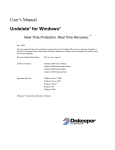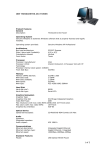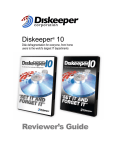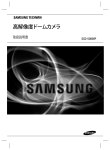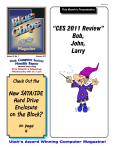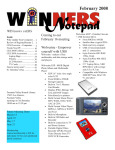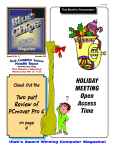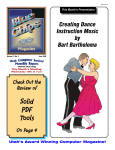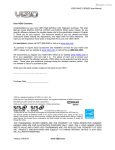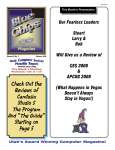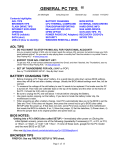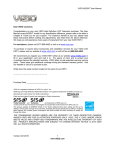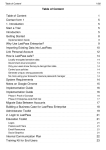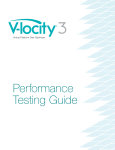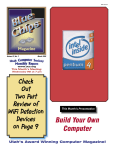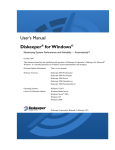Download Check Out the Report of Security News & Views On Page
Transcript
ISSN 1061-5725 This Month’s Presentation Backing Up Your Hard Drive using Acronis True Image Volume 26, No. 11 November 2008 www.ucs.org This Month’s Meeting: Wednesday 12th at 7 pm Check Out the Report of Security News & Views On Page 4 And Review of Undelete 2009 Professional Gene Barlow has been a guest speaker in the user group community for over 25 years. He has presented to the Utah Computer Society on various topics many times in the past, starting back in 1996 when Gene and his family lived in Lindon, UT. Gene and his wife, Linda, now live in beautiful southern Utah, St. George, just 40 minute away from Zion’s National Park. Gene’s topic is “Backing up Your Hard Drive”. Acronis just announced a significant new release of their top rated backup utility, Acronis True Image Home 2009. To read Gene’s newsletter in full about the dozens of important new features in this product, you can go to www.ugr.com/nl1008.html. Make sure you are adequately protected and can recover from any unforeseen events such as viruses, unstable software downloads, and hard drive failures by having a well thought-out backup plan. Having a good backup system is essential in order to put your system back together again in a few minutes, not days or weeks. This is an important topic that every PC User should implement on their computer. Don’t miss this meeting. Utah’s Award Winning Computer Magazine! ™ By Cliff Millward, Editor [email protected] How About this Web Address? Jennifer Thornburg legally changed her name to CutoutDissection.com --cutout for short. She wanted to do something to protest animal dissections in schools. The moniker is also the Web address for the anti-dissection page of the site for People for the Ethical Treatment of Animals. Will this start a trend? Will you change your name to ucs.org? What about Microsoft.com? Panyo or Sansonic? Panasonic and Sanyo are contemplating a merger. The companies hoped to complete a deal by the end of the year. Panasonic did not say how much it planned to offer Sanyo. The consumer electronics industry is reeling from a sharp drop-off in sales, and Sanyo is in trouble. Recent Trends I can see the law suits forming already. Line up lawyers, the gravy train is rolling in! Apples & Oranges? No -- Blackberries! According to a recent study Apple’s iPhone has half the failure rate of RIM’s BlackBerry. Also, Apple has overtaken RIM in smartphone sales. After all, “Get Smart” used a shoe for communications, so why not use fruits and vegetables -- or anything else for that matter? Would you like to see my new hard drive phone? It stores a terabyte of phone numbers (and uses Linux.) Guitar Hero gets Restrung The game now has a drum kit and microphone, in addition to the mock guitar. Panasonic, is interested in acquiring Sanyo because of its leading position in rechargeable batteries and solar cells. Their batteries are widely used in cell phones and laptop computers and solar cells may well be the way in the future. Firefox reaches 20% Firefox has passed the 20 percent market share for the first time recently. They still have a long way to go before they threaten Internet Explorer, but they are making slow progress by producing an excellent product. A new Firefox will be out shortly which will feature “Private Browsing.” This feature is about making sure that the browser doesn’t store any data which can be used to trace your online activities. This means that no one will know what you did during your online session. USB SuperSpeed This month a SuperSpeed USB specification will enter the market and be available sometime in 2009. All future PC’s will include the connectors based on it. The new connection is expected to offer 10 times the speed of the “old” USB 2.0 (5 gigabits per second.) In case you have never seen this thing in action, the players try to match lights moving across the screen with the string positions on the mock guitar. It keeps count of the mistakes you make and at the end of the song grades you on your performance. The specification would have been available sooner, but Inter and Nvidia have been fighting over the standard. However, they seem to have resolved their differences. The new version has 80 tracks of popular songs. Oh joy, another new plug in device! Help -- where do I plug in this wire? Finè Page 2 Blue Chips Magazine — November 2008 Blue Chips Magazine “Utah’s Award Winning Publication” Magazine Staff Editor — Cliff Millward Review Program Liaison — James Alexander Review Product Editor — Donna Nendell Review Editor/Product Recruiter — Don Nendell Photography — LeRoy Johnson Proof Reader — Larry Lamph, Doug Jackson Advertising Rates Ad costs 2 Page Spread Full Page Half Page Quarter Page Business Card 1 month $150 $100 $50 $25 $15 3 months $400 $275 $130 $70 $30 Charter Member of the Association of PC User Groups 955-9633 250-2269 565-9594 565-9594 6 months $700 $500 $250 $130 $60 12 months $1200 $900 $450 $225 $120 Full page size is 7½ x 10 inches. All other page sizes are based on a 7 x 10 inch page in order to conform to editorial style. Half-page ads may be 7 x 5 inches or 3½ x 10 inches. Quarter-page ads are 3½ x 5 inches. Business card ads are 3½ x 2½ inches. Classified Advertising Utah Blue Chips members may place personal classified ads at no charge. Maximum ad size is 7 lines, 35 characters per line. Submissions Members are encouraged to submit text articles for publication in ASCII text only. Photos in .TIF or .JPG format only. Line graphics, tables, in almost any vector or .TIF format. Do not imbed graphics or tables in text files. All articles must be received by the 15th of the month preceding the month of publication. All articles become the property of the Utah Computer Society and by submitting an article, the author gives permission for the Blue Chips Magazine Staff to edit the submission. The author also gives permission for republication in other users groups’ communications. Officers and Trustees Eve. Phone E-mail President, Stuart Gygi V. Pres., Larry Lamph Secretary, Lowell Kenedy Treasurer, John Witzel Doug Jackson 576-1891 571-2908 278-3035 296-1390 322-2337 [email protected] [email protected] lkenedy@ucs,org witzelj@ucs,orgtt [email protected] Information Persons or companies may join or renew at the meeting, or by sending a check payable to the Utah Computer Society to: Utah Computer Society Membership Secretary 5435 Riley Lane Murray, Utah 84107 Individual memberships are $25/year. Business Memberships are $35.00 a year. Corporate sponsorships are available at two levels. Corporate Sponsors enjoy all benefits of membership including multiple individual membership and prepaid advertising coverage. Contact a Board Member for more information. Other important information: Permission to Copy Permission is granted to other nonprofit PC user groups to reproduce any article published in this newsletter, provided credit is given Blue Chips Magazine and the author (s) of the reproduced materials. Reprinted articles are subject to the terms of their respective copyright holders. Meeting Information Group Business (James Alexander) Magazine (Cliff Millward) Web Site WebMaster Membership (evenings) (Bob) http://www.ucs.org 250-2269 955-9633 http://www.ucs.org 262-6045 262-6045 MONTHLY MEETING LOCATION 2nd Wednesday of every month November Renewals LeR Burton Doug Jackson Jared Motogawa Don Nendell University of Utah, Union Building, 7:00 p.m. Page 3 Blue Chips Magazine — November 2008 Security-Related News & Views (cont.) Part 3: Cyber Security Awareness 101 Reported by Don Nendell “To be seventy years young is sometimes far more cheerful and hopeful than to be forty years old.” – Oliver W. Holmes Prolog Howdy again. A number of significant events have occurred since my last Security-Related News and Views (cont.) Report (See the Report in the September 2008 BCM Archives1). So, what’s wrong with this picture? You’re reading this in the month of November 2008, and I’m reporting to you (I’m actually writing this in October) that October 2008 was designated National Cyber Security Awareness Month (NCSAM) by DHS. Actually, I’m very skeptical about anybody’s “Cyber Awareness,” let alone that this is the 5th consecutive year this program has been in existence? Truth be known. This is my 57th Security-Related Report/Review published here in BCM over the years, and even I was blissfully, “totally unaware,” to coin a phrase, that such an event was even going on - let alone its very existence. I was caught completely off-guard, and flabbergasted. Supposition. It’s not just a case of 10% not getting the word, either, I doubt very seriously if a full 90% of the people haven’t gotten the “Cyber” word yet - let alone any “Awareness” of it? It appears to me that the program hasn’t carried a great deal of weight after five (5) years of existence? I could be wrong; although, every one I’ve mentioned the program to, so far, hasn’t known of its existence either? The Jury’s still out on that one, I believe. However, this has got to change, folks. It’s far too serious of an international problem for it not to… this could turn out being a catastrophe actually? This is akin to that, socalled, “Weatherperson” on TV saying, “There’s a 10% chance of showers today?” So, who actually cares? Answer. To those folks who do get hit in the face with those showers, it’s now a 100% “Chance of showers?” The same actually holds true with “Cyber Awareness.” You really don’t want to mess with the catastrophic consequences of “Naivety and/or ignorance” of those facts of life, either. Said, period. I heard (or read?) this somewhere? “You can’t know where you’re going unless you know where you are?” Must be a Yogi Berra saying, you think maybe? Which means I’ve got some Good news, and some Bad news, to report this time around? First. The Bad News As Per Usual The “Bad Guys” are still going at it “Hammer” (Russian Mafia) and “Tong” (the Chinese, of course). Page 4 Blue Chips Magazine — November 2008 Security Report The 800 pound gorilla (NSA) is pounding away “harder” than ever (See CBC2 ABCWorld News graphic), plus a whole host of other “Baddies,” as per usual. And, they “All” only seem to get “Badder and Badder.” to coin a phrase. Ergo, herewith are some samples for your elucidation, education and edification that I’ve ferreted out during my NCSAM, et al., Internet search for this Report (See also “Now, For the Good News” Below): 1. 2008 Brings Record Number of Data Breaches (Processor.com News October 24, 2008). A recent study from the Identity Theft Resource Center found that there have been 524 large security breaches so far this year. The report indicates that the identities of up to 30 million consumers may have been exposed. Even at this point in the year, the number of consumers possibly affected by the data breaches is greater than all of 2007. 2. Zombie PCs Increase (Processor.com News October 24, 2008). The number of compromised computers functioning as botnet PCs delivering spam increased dramatically from August to September, according to a report from Symantec. The Symantec report found, on average, a 101% increase of botnet spam in September. In addition to the increase in botnet PCs, Symantec notes that there was also an increase of email messages carrying malware payloads rather than just links to malicious code. The study indicated that spam now accounts for 78% of all email, and the greatest percentage of spam attempts to redirect you to another Web site. Spam of a financial nature was the second most common classification. 3. U.S. must secure its systems and cyber infrastructure against botnet attacks, by Ashar Aziz (GSN: Government Security News, October 2008) “The FBI estimates losses due to computer crime were $67.2 billion for U.S. organizations in 2005, and ranks fighting cyber crime behind only terrorism and foreign counterintelligence investigations. Fueling the surge in cyber crime is a lucrative cyber crime economy. Criminals infect PCs with malicious software (“malware”) and sell access to - and the data on - these i n f e c t e d PCs. Add central management of those infected PCs and they have a “botnet”. A single botnet, which can be comprised of tens of thousands of infected PCs under the control of an adversary, poses a significant threat to our national security and information economy.” 4. Russian “hacktivists” used Turkish botnets to attack Georgia, by Jacob Goodwin, Editor-in-Chief, (GSN: Government Security News. September 23rd, 2008) “Many of the cyber attacks that were launched against government computers in the nation of Georgia - which coincided with the real-world military attacks by Russia against that country last month - were actually carried out by computers sitting in Turkey that had been captured by Russian “hacktivists” and drafted into huge, unwitting botnet armies.” 5. On the personal side of the ledger. Last month (October) was a most notable one for me starting with the sudden arrival of an e-mail proclaiming the spread of “the worst virus ever!” This one certainly bears repeating: Netlore Archive: False email alert warns of ‘the worst virus ever’ circulating in the form of an attachment labeled ‘POSTCARD’ or ‘POSTCARD FROM HALLMARK’ Description: Email hoax Circulating since: Feb. 2008 (this version) Status: False, although real e-card viruses resembling this do exist. Comments: With so many real viruses in circulation bearing names almost identical to the bogus threats you may read about in hoax messages, it is crucial to know how to distinguish between the real virus threats and the fake ones. Here are a few points to keep in mind: 1. It is true that there are real viruses, Trojans, and other malicious programs currently being distributed by means of fake e-card notices. Note. These malware-containing emails may arrive under any of dozens of possible headers, for example: • You’ve received a Hallmark ECard! • You’ve received a postcard from a family member! • Colleague sent you a postcard from egreetings.com! • Birthday e-card 2. They do resemble legitimate notices from e-card companies. This means every user needs to be very careful when dealing with such emails, no matter what the apparent source. Before clicking on any links or attachments in the body of such a message, check to see if you can verify that it came from a legitimate source - and that isn’t always easy. If you can’t verify, don’t click! 3. Don’t click on links or attachments in e-card notices that arrive anonymously, or from senders whose names you don’t recognize. 4. Don’t click on attachments or links that seem suspicious in any other way. 5. Generally speaking, forwarded email warnings such as the ‘POSTCARD’ alerts above cannot be trusted to provide accurate information. Caveat. Read carefully! Try not to confuse hoax warnings with the real thing. Bogus virus alerts often contain links to websites which, at first glance, may seem to confirm the authenticity of Page 5 Blue Chips Magazine — November 2008 the message, but which in fact discuss a completely different matter. The very message we’re discussing happens to be a case in point. Despite the fact that there are real e-card viruses out there, the “POSTCARD” warning above is, in fact, a hoax. It is simply the newest of many variants of a false alert that began circulating several years ago. Therefore, don’t depend on this type of alert for protection, and avoid forwarding such messages to others unless you can confirm with some certainty that the threat they describe is real. 6. Protecting yourself from real virus and Trojan threats entails a few simple but critical measures. Follow them religiously: a) Always be very careful concerning which attachments you open and which files you download. If you can’t be reasonably sure they are safe, don’t open or download them; b) Maintain up-to-date antivirus software on your computer, configure it to detect Trojan horses and other malware automatically, and scan for viruses and other threats regularly (Please see my December 2007 Review1 of Cyber Defender Ultimate and Complete 2008); and, c) Always be careful concerning which links you choose to click, especially in messages from anonymous or unfamiliar sources. Clicking on these links can instantly download malicious software onto your computer. Again, if you can’t be reasonably sure a link is safe, don’t click on it. Source: Urban Legends <http:// urbanlegends.about.com/library/ bl_postcard_virus.htm> Then to top it all off, James Bamford, an American bestselling author and journalist who writes about United States intelligence agencies (his first book, The Puzzle Palace (1982), was the first book published about the National Security Agency (NSA)), came out with his fourth book on September 16, 2008, The Shadow Factory: The Ultra-Secret NSA from 9/11 to the Eavesdropping on America (Doubleday. ISBN 0385521324). The flyleaf states, “… He shows how new technology, the NSA’s lack of oversight, and billions Page 6 Blue Chips Magazine — November 2008 Page 7 Blue Chips Magazine — November 2008 Page 8 Blue Chips Magazine — November 2008 Page 9 Blue Chips Magazine — November 2008 Page 10 Blue Chips Magazine — November 2008 Page 11 Blue Chips Magazine — November 2008 in post-9/11 dollars have combined to give the agency an almost Orwellian ability to eavesdrop.” Coincidently (Remember the Celestine Prophecy’s First Insight?) with the release of The Shadow Factory, ABC World News did an “Exclusive” interview with two (2) of the “Whistleblowers” spotlighted in his book (See also the CBC2 graphics accompanying this Report). I first met James at DEFCON X (in Las Vegas) and asked him how has he eluded the Feds “Kill Squads” with his exposes of the NSA? “It wasn’t really as scary as that, besides, I’m a lawyer!” he responded. “Oh Yeah, I’ll bet,” I responded. Truly, I am mightily impressed with the courage James has displayed in publishing his four (4) books about the NSA. I have enjoyed each and every one, and needless to say, I’ve learned so very much from each of them as I developed my DYCRAV™ Security Suite IT, lo these past thirteen years. The Shadow Factory is probably the scariest “WakeUp Call” of them all, I truly believe. You really must read it (and all of them, to be sure) for yourself to believe that last “Orwellian” statement. As proof, FYI Here’s an excerpt from the Chapter entitled: Trailblazer: “Well beyond word spotting, NSA is also developing another tool [known as Acquaint, which stands for “Advanced QUestion Answering for INTelligence] that Orwell’s Thought Police [George Orwell’s classic dystopian novel 1984] might have found useful - an artificial intelligence system designed to know what people are thinking [my emphasis here]. With the entire Internet and thousands of databases for a brain, the device will be able to respond almost instantly to complex questions posed by intelligence analysts. As more and more data is collected – through phone calls, credit card receipts, social networks like Facebook and MySpace, GPS tracks, cell phone geolocation, Internet searches, Amazon book purchases, even E-Z Pass toll records – it may one day be possible to know not just where people are and what they are doing, but what and how they think. The system is so potentially intrusive that at least one researcher has quit, citing concerns over the dangers in placing such a powerful weapon in the hands of a top-secret agency with little accountability.” Hot, shocking stuff, that! With that, flashback now to the 1998 Enemy of the State film starring Will Smith, Gene Hackman and Jon Voight (Tagline: “It’s not paranoia if they’re really after you,” and “The only privacy left is inside of Page 12 Blue Chips Magazine — November 2008 your head”). See also the YouTube (2:36 min) trailer (plus others) of the film at <http://www.youtube.com/ watch?v=R90vWtcHLlE>. “If you don’t know where you’re going, you’re unlikely to end up there.” - Forrest Gump One(?) More Thought Before I Venture Onward Re. Sarah Palin’s E-Mail Hacked <http://www.time.com/time/ politics/article/0,8599,1842097,00. html> 10 important points Alaskan Gov. Sarah Palin has taught us about E-mail? (September 18th, 2008 Posted in News) * When creating a free email account it’s OK to lie. Never give your real information to anyone asking for it online unless it’s required. * Use a strong password. Find out how long you can make your password, what characters are valid, and use something like KeePass Password Safe to manage your passwords. * After you create the email account and create a strong password, save the false information you entered in your password manager. That way if you change your password, but don’t save it in your safe, you have the false information you need to reset the password. * Never use your email account for anything other then public communication. Don’t forget once you hit send, you have no control over what others do with your email. * Never leave email on the server. Either download it to a computer or delete it. Why would an attacker go after your computer, when they can attack your email. Ever do a search in your mailbox for keywords like “password”, “login”, or other sensitive information? You will be shocked what you might find. * If you need to send something, that isn’t meant to be public, use encryption [my emphasis here]. Check out Hushmail if you want free and easy (Please see also my August 2008 Review1 of CMS’s CE Secure Vault Edition Pro and my August 2006 Review1 of AutoEnc). * If using web email, disable POP3 and IMAP access. Setup your emails to automatically be forwarded to your main account and auto delete whatever is on the server. * If you do need POP3 or IMAP, only use if SSL is enabled. * Test the “forgot password” function for your account. If it seems too easy to reset, it might be easy enough for an attacker. Just ask Gov. Palin. * Learn to use temporary email addresses. Web sites like 10 Minute Mail can be used for online registration for web services. Do what you can to keep your email address from making the rounds. Now, For the Good News In case you missed all the fun, as mentioned above, October was the (5th consecutive) National Cyber Security Awareness Month (NCSAM). BTW For me it’s National Cyber Security Awareness 24/7/365, just as it should be for all of you out there in “No-No” land. And please accept my apologies for the tardiness in alerting you about this stellar event. “No Excuse, Sir!” “Wisdom is the power to put our time and our knowledge to proper use.” – Thomas Watson However, Better Late Than Never You may be asking yourself? What is Cyber Security Awareness? The Oxford English Dictionary defines awareness as: “The quality or state of being aware; consciousness.” And aware is defined as: “Informed; cognizant; conscious; sensible.” And, Webster’s New World Dictionary of the American Language further defines awareness as: “Knowing; realizing.” OK? OK! A Little Background Music, Maestro, Please? Each year, the National Cyber Security Division of the U.S. Department of Homeland Security (DHS) provides tools, tips, and information on cyber security to homes and businesses to promote safe online activities. The aim of the project is to educate users on ways of avoiding cyberattacks and what to do if their systems are compromised. “Cyber attacks are increasing in sophistication and frequency every day. They include a broad spectrum of nefarious activity - from an individual hacker, to an organized criminal group stealing information or identities, to nation states engaged in cyber espionage,” said Homeland Security Secretary Michael Chertoff. “We have embarked on a massive effort to guard federal systems and to work with industry to defend our critical infrastructure. Because no single entity owns the Internet, the federal government needs the cooperation of both the private sector and everyday citizens to protect against a range of cyber threats.” Page 13 Blue Chips Magazine — November 2008 One (1) More Sample Should Be Ample Here’s but one (1) example of the multitude of the dangers we all face today, repeat today - and Everyday: During National Cyber Security Awareness Month, Comcast Warns Consumers to Watch Out for the Internet’s Fastest-Growing Cyber Crime...Bots: Comcast Provides Tips on Preventing Online Identity Theft (By BusinessWire) PHILADELPHIA, BUSINESS WIRE According to the National Cyber Security Alliance, bots are the Internet’s fastestgrowing cyber crime and 71 percent of consumers lack knowledge about this online threat (My emphasis here). October is recognized as National Cyber Security Awareness Month and as the nation’s largest residential Internet Service Provider, Comcast is committed to informing consumers about how to have a safe and secure online experience. “Online criminals are savvy and are developing more sophisticated ways to steal personal data, financial information, and the entire identities of unsuspecting people,” said Jay Opperman, Senior Director of Security and Privacy at Comcast. “According to the Federal Trade Commission, as many as nine million Americans have their identities stolen each year so it’s important that consumers learn how to protect themselves and their families from online scams that can lead to identity theft.” A bot, also known as a Web robot, is a form of malicious software that is used to gain control over a computer. Once a bot is in control, the computer can be used to send spam, host phishing sites or infect other computers. Online thieves use bots to collect personal data about people such as their social security numbers, bank account information, and credit card information. When this personal data is collected, it is often used maliciously which can result in identity theft. A person can unknowingly infect their computer with a bot by not protecting his or her PC with anti-virus and security software, opening suspicious e-mails and/or e-mail attachments, or downloading software from a Web site with an unknown or falsified brand,” said Opperman. Signs that indicate a computer may be infected with a bot include: - Numerous undelivered e-mail notifications in your inbox to unknown e-mail addresses. Bots will frequently use e-mail accounts to send out spam. Spam to unknown e-mail addresses will result in a failure to deliver notification in your inbox. - Suspicious e-mail account activity. Bots create multiple e-mail addresses in your e-mail account. If you notice additional e-mail addresses in your account, that you did not create, you may have an infected computer. - Multiple toolbars on your Internet browser. Bots will frequently install various toolbars to help collect search information from your browser. - Frequent flashing of the data light on your cable modem. If the data light constantly flashes for a period of days when you are not using the Internet, a bot could be operating on the computer. - Unusual error messages. Error messages that suggest applications cannot run or drives cannot be accessed can be indications of a bot infection. To help prevent a bot infection, Comcast recommends the following tips: - Keep your computer protected by downloading reputable anti-virus and security software. - Make sure your computer is set to receive auto security updates. - Avoid downloading software from a Web site with an unknown or falsified brand. - Do not click through or open suspicious e-mails or e-mail attachments. - Avoid social networking scams - never provide your personal information (i.e. social security number, credit card numbers) to e-mails that solicit this information, even if the e-mail looks to be from a legitimate company or brand that you recognize. A legitimate company would not request this information via e-mail. Note. For more Internet Safety tips, visit <www.Comcast.net/security>. security is more than a collection of applications and tools; “security is a mindset” (My emphasis here, see also Bruce Schneier’s explanation of “Security Mindset” in the Undelete 2009 Pro Review that follows this Report). Being aware of security is absolutely essential, more so today than ever before. We are reminded that “Making security an integral part of your daily activities - or even just paying due care and attention as you surf the Internet - is an important process.” There are definite layers to security. There is the human layer, and then a layer that deals with tools, both software and hardware related. The human layer of security is complex. There is nothing that will identify a person as criminal for example, or one that will predict or detect that Joe Blow in HR is stealing company assets. Likewise, while there is an abundance of hardware and software-based security on the market today, no one single tool can do it all. Important Notice (See also the CBC2 graphics accompanying this Report). One of the better web sites specifically related to NCSAM which covers some aspects of security out there is the University of Texas San Antonio <http://www.utsa.edu/cybersecurity/>. Another first rate web site also covering many aspects of security is the University of Auburn <http://keepitsafe.auburn.edu/>. And some really great published Security material can be seen at the Multi-State Information Sharing and Analysis Center web site <http://www.msisac.org/awareness/ oct08/index.cfm>. And finally, a very Security is Constantly Evolving Security is something that constantly evolves. One thing that needs to be remembered however, is that Page 14 Blue Chips Magazine — November 2008 valuable Resource Kit for National Cyber Security Awareness Month (and other Security-Related endeavors) can be found at EDUCAUSE <http:// www.educause.edu/7479>, a nonprofit association whose mission is to advance higher education by promoting the intelligent use of information technology. They’re all great. Please check them out! Lest We Forget If there could be any doubt in your mind at all, at this juncture, as to the rationale behind this Security Report, and the need for a National Cyber Security Awareness Month, I respectfully submit for your edification the tag line for the 2008 Black Hat Briefings and Training conference was: Know who you’re dealing with online; 3. Use anti-virus software, a firewall and anti-spyware software to help keep your computer safe and secure; 4. Set up your operating system and web browser software properly, and update them regularly; 5. Use strong passwords and strong authentication technology to help protect your personal information; 6. Back up important files regularly (Please see also my September 2008 Review1 of NTI’s BackUp Now 5); “The war for your data rages on. Be certain your defenses are up to the job.” And from my all-time favorite Security magazine, Eye Spy, I leave you with a couple of eye-opening, thoughtprovoking graphics to ponder <eyespymag.com>. Kindly remember that “they” are all after your identity, so guard your “Stuff” judiciously. It’s all about money! 7. Learn what to do if something goes wrong; and, 8. Protect your children online. Well, that certainly ought to be enough for this episode of “Boo!” from your local Boogie man? Ciao! Footnote 1 See the actual Reports/Reviews in the Blue Chips Magazine Archives at <www.ucs.org>. Note. Always choose the .pdf format for its beauty. In Summary According to the StaySafeOnline.org (National Cyber Security Alliance), while there is no single cyber security practice or technological solution that will prevent online crime, computer users can follow the following guidelines: 1. Protect your personal information; 2. Page 15 Blue Chips Magazine — November 2008 Undelete 2009 Professional Windows Review Real-Time Protection. Real-Time Recovery Reviewed by Don Nendell Manufacturer: Diskeeper Corporation 7590 N. Glenoaks Blvd. Burbank, CA 91504 Phone: (818) 771-1600 / (800) 829-6468 FAX: (818) 252-5514 E-mail: [email protected] Sales Phone: (800) 829-6468 Customer Support Contact: 8:30 A.M. - 5:30 P.M. Pacific Time E-mail: tech_ [email protected] Note. All Diskeeper manuals can be downloaded online Product Support: Registered users receive 90 days of free telephone support and special upgrade pricing. Plus, a free Technical Support web site contains a searchable Knowledge Base (KB). Note. Diskeeper Corporation’s philosophy in regards to Customer Support is to provide service as near-instantly as possible. They also have one of the best-trained Support staffs in the business. If possible, they like to get your questions answered on the spot. In the event that it is not, they will ensure that you get your answers as quickly as they possibly can. Web site: www.undelete.com Blog: www.diskeeperblog.com Knowledge Center: www.diskeeper.com/ products/documentation/documentation.asp Available Undelete 2009 Editions include: Home, Professional. Server and Desktop Client All are available at major retail stores, online resellers, or they can be downloaded from their web site Note. One (1) Undelete license is required for each computer Undelete 2009 protects. Undelete 2009 is now available in English, French and Japanese. More information is available at <www.diskeeper.com> Pricing: Undelete 2009 Home $29.95 (13.0 MB Download) Undelete 2009 Professional $59.95 (13.1 MB download) Undelete Server $499.95 (includes 10 Desktop licenses) Undelete Client $19.95 (Minimum of 20 licenses) Note. Professional Edition upgrades require Undelete Professional 3 (or higher) System Requirements: The various editions of Undelete run on the Intel® x86 platform (including the Intel Pentium™ and Pentium-compatible CPUs from other manufacturers) running Microsoft Windows XP (Professional / Home / Tablet PC / Media Center editions), all versions of Windows Vista, Windows 2000 (all Professional and Server editions), and Windows Server 2003 (all editions) About Diskeeper Corporation - Innovators in Performance and Reliability Technologies With over 30 million licenses sold, home users to large corporations rely on Diskeeper software to provide unparalleled performance and reliability to their laptops, desktops and servers. Diskeeper Corporation further provides up-to-theminute data protection and instant file recovery with Undelete. Diskeeper Corporation, formerly Executive Software, was founded by Craig Jensen on July 22, 1981. Since that time, the Diskeeper automatic defragmenter has led the industry in defragmentation technology. Originally released in 1986 for the Digital VMS platform, Diskeeper became the first and original “Set It and Forget It®” automatic disk defragmenter for the enterprise. Introduced with the release of Windows NT v 3.51, Diskeeper became the first-ever Microsoft Certified defragmenter on November 22, 1999. More recently Diskeeper became the first defragmenter to receive Microsoft certification for Windows 2000 Advanced Server, and for Windows 2003 Enterprise Edition - whose advanced level certifi- Page 16 Blue Chips Magazine — November 2008 cations require stringent testing and compatibility with Windows clustering. Diskeeper Products Overview: Diskeeper Corporation provides automatic disk defragmentation, fragmentation analysis, the most complete file recovery system for lost files on Windows 2000, XP, Server2003, 2008, Vista and mixed Windows networks, and automatic data caching software. Products for VMS and OpenVMS on the VAX and Alpha platforms include Diskeeper, FragGuard, Filemaster and I/O Express®. Diskeeper Factoids Unit sales of Diskeeper have now reached an 89.8% market share in System Utilities/General Disk Utilities sold according to data from The NPD Group’s Distributor Track®. Of this, Diskeeper is the top standalone defragmenter on the market, accounting for 99.2% of 3rd party defragmenter unit sales in the entirety of North America. According to leading independent IT testing lab engineers at NSTL, the negative impact fragmentation has on system performance is far greater in the enterprise then previously envisioned. Through extensive testing conducted by NSTL on Windows based enterprise systems, documented evidence of performance gains from 56% to 200% (on average) could be realized after defragmentation of servers and workstations. Further corroborating NSTL’s findings, IDC analysts separately report that corporations are losing as much as $50 billion per year as a result of not defragmenting every server and workstation on the network. Prolog FYI This is going to be a multipurpose type Review - it is not simply going to be just a Diskeeper Undelete 2009 Review. Oh no! The reason being, this is because the real problem is actually much bigger than all that and as Paul Harvey would intone, “This is simply a means to an end!” Page 1... To Begin With I intend to handle this Review in the manner to which it should become accustomed, to wit, a Security-Related Review - my 58th to be exact (More on that in a bit). (For an update, see the CBC2 graphics leading in to the Security-Related News and Views (Cont.) Part 3 Cyber Security Awareness: 101 Report earlier in this issue of BCM). Page 2... Caveat Hang on, we’re getting to the actual Review itself, but first, you’ve got to understand precisely “Why you should protect your PC’s with applications like: Diskeeper’s Undelete 2009 Pro; Diskeeper 2008 Pro Premier (See my January 2008 BCM Review1); BACKUP NOW 5 (See my September 2008 BCM Review1); an Antivirus program like CyberDefender Ultimate (See my December 2007 BCM Review1); a SpyWare program like Spy Sweeper (See my May 2007 BCM Review1); Firewalls, Knives, Guns, Guard Dogs - even Burglar Alarms connected to a monitoring company, et al.?” Sorry! I got a little carried away there again, and although I was unable to attend my 8th DEFCON (Hackers) convention <www.defcon. org> and my 4th Black Hat Briefings this year in Las Vegas, I’m still - and perpetually – absolutely shaking in my boots. For me, it’s an ongoing “Dejá Vu all over again.” Nothing ever seems to change - no matter how much mud I “Throw up on that Security Wall?” You’d think that maybe some of it would stick, sooner or later, wouldn’t you? For what it’s worth, I must be some kind of a “Post Turtle,” or some such? Don’t know what that is? The alleged story goes something like this: “When you’re driving down a country road, and you come across a fence post with a turtle balanced on top, that’s a ‘post turtle’. You know he didn’t get up there by himself, he doesn’t belong up there, and he doesn’t know what to do while he’s up there, and you just wonder what kind of dumb... put him up there to begin with.” Apt, you think? Don’t answer that! ;-} Universe is like a safe to which there is a combination, but the combination is locked up in the safe.” “I can see it clearly now,” said the blind man, nodding his head in agreement, as he picked up his file and started sharpening the teeth on his saw. Anywho! FYI Take A QUICK Gander at DEFCON 16’s 3-day Schedule of Events if you want to get an eyeful of FUD (Fear, Uncertainty and Digital Armageddon) I’m throwing around here. First, the basic DEFCON 16 web site is at: <http://www.defcon.org/ html/defcon-16/dc-16-post.html>, and the 3-day class schedule is at: <http:// www.defcon.org/html/defcon-16/dc16-schedule.html>. Second. Do criminals go to DEFCON? You bet they do. They also go Bruce Schneier does seem to have an answer, however, I think. “This kind of thinking [Security Mindset] is not natural for most people. It’s not natural for engineers. Good engineering involves thinking about how things can be made to work; the security mindset involves thinking about how things can be made to fail. It involves thinking like an attacker, an adversary or a criminal. You don’t have to exploit the vulnerabilities you find, but if you don’t see the world that way, you’ll never notice most security problems. I’ve often speculated about how much of this is innate, and how much is teachable. In general, I think it’s a particular way of looking at the world, and that it’s far easier to teach someone domain expertise - cryptography or software security or safecracking or document forgery - than it is to teach someone a security mindset.” CRYPTO-GRAM, April 15, 2008 <schneier@SCHNEIER. COM> “The strongest human instinct is to impart information; the second strongest is to resist it.” - Kenneth Grahame, Scottish author And another answer, maybe? Novelist Peter de Vries once said, “The Page 17 Blue Chips Magazine — November 2008 to high school and college, and work in your workplace and the government, amongst others. FYI There are also lawyers, law enforcement agents, civil libertarians, cryptographers, plus all the hackers, in attendance, too! “However, don’t tell anyone I told you?” OK? OK! Caveat. Regardless, you all simply have got to learn to protect yourself better, and that’s been my intention all along truly - to help as best I can. Page 3... Soapbox Stuff Thankfully there’s more help out there besides our other beloved members of Blue Chips (re. Those Members Helping Members), and we all certainly need all our valuable local volunteer organizations’ help, that’s for sure. FYI eZines like Smart Computing, their web site’s at: <www.smartcomputing.com>, and CNET TechSpecials, immediately come to mind. Their web site’s at: <CNET_Networks_Member_Services@newsletters. online.com>, For our purpose herein - plus introducing you to their services, take this relevant CNET TechSpecials “Weekly Question Section”, for example: CNET TechSpecials (August 25, 2006) From: CNET_Networks_Member_ [email protected]: “I have a hypothetical question: What if you’ve accidentally deleted important files, emptied them from the recycling bin, [and] then want to get them back? If you immediately realize what you did, is there anything that can be done to get the files back? Is there any software I can purchase to recover those files? Are there any available recovery services? What other steps should I take in [an] event like this – [besides] turning off the computer right away? Is there any hope to recover these files, or are they gone for good? I hope these questions don’t sound silly to you, but I want to know just in case I ever do such an unthinkable mistake. Thanks! -Submitted by: Katherine R. of Glendale, California” Note. Everyone interested in all the responses to Katherine’s question will simply have to go to the web site (See above) to get the multitude of actual CNET TechSpecials “members” answers. Meanwhile, while you’re there sign up for their weekly e-mails, you’ll be exceptionally glad you did. However, you must, by now, already have your first inkling (clue?) as to what I’ll be suggesting belatedly to Katherine R. right about here, don’t you? Well, keep on reading! Page 4... And Now, the Rest of the Story! Katherine, in answer to your question, Diskeeper advertises Undelete 2009 (UD2009) as being, “Worryfree data protection with instant file recovery – recover deleted files faster than going to backup!” “You are in ‘Safe Hands’ now, Katherine.” data recovery. The UD2009 product family allows home users, network clients, or systems administrators (without their ever having to leave their desk - which is a first-ever achievement for any platform) to immediately recover those accidentally deleted or saved-over files. including files commonly missed by Windows Recycle Bin, as well as, files that have been saved-over or deleted across a network. In addition, Undelete’s real time protection surpasses the occasional data protection provided by Windows Volume Shadow Copies, removing all gaps from the data This is how UD2009 does it. Undelete replaces the basic Windows Recycle Bin with its own, powerful Recovery Bin. The Undelete 2009 Recovery Bin captures all data, protection strategy to ensure data is never lost. By protecting all files and providing means for instant recovery, Undelete 2009 creates an indestructible data defense. A “Quickie” Rundown of Undelete 2009 Undelete 2009 provides real-time data protection and real-time instant Page 18 Blue Chips Magazine — November 2008 Undelete 2009 includes: 1) InvisiTasking, a Diskeeper background processing technology with zero overhead, first introduced in Diskeeper 2007. This ensures that UD2009 operates completely transparently, consuming resources only when not used by the operating system; 2) Version Protection for Microsoft Office files, which provides a simple, intuitive recovery of earlier or “saved over” versions of Microsoft Office (Word, Excel and PowerPoint, for example) files; 3) SecureDelete 2.0, now with Wipe Free Space which completely erases sensitive files and wipes free space according to Department of Defense (DOD) standards (more on this in a moment, to be sure); and, 4) Emergency Undelete (See also Below). In a nutshell, the Undelete 2009 instant recovery product saves time by recovering the broadest possible range of accidentally deleted files and has become the industry leader in file protection. So, What’s it All About Alfie? Accidental (and malicious) file deletions are unavoidable. You have but to think of all the valuable data on your home computer (or, your office or network?): Financial records, work and school documents, Microsoft Office files (like PowerPoint presentations, Word documents, et al.), database files, or even those precious once-in-alifetime digital photos that you’ll never be able to take again, or possibly your AVI files (videos), MP3 files (songs), etc., etc. Well, here’s a real frightening thought for you. What if Katherine R’s (See above) fears actually happened to you (i.e., they really did come true?), and consequently, any/all of those files were accidentally deleted and you couldn’t get them back? It’s a fact of life, accidental file loss, through deletion and/or over-writing, more often, and is a lot easier, happens than one might think. And here’s the worst part: Windows doesn’t capture all deleted files in the Recycle Bin either. So, what can one do when one is faced with this frightening dilemma? The answer is really quite simple actually. Undelete 2009 replaces the Windows Recycle Bin with a catch-all Recovery Bin that intercepts all deleted files, no matter how they were deleted. Hoorah! Caveat. However, be forever forewarned, it’s an entirely different story if the files have been “Destroyed;” which Undelete 2009 can actually do with the SecureDelete option (See below) – which to me is the “Security-Related Coup de Grace”. Baby, when you hit that “SecureDelete Enter Key” you’ll immediately hear the Kingston Trio’s 1959 version of the “The M.T.A. Song” - better known as “Charlie on the M.T.A” come blaring out of your speakers. Chorus: “Did he ever return, No he never returned And his fate is still unlearn’d He may ride forever ’neath the streets of Boston He’s the man who never returned.” Just kidding. But you can rest assured, “They’ll never return . . . on the MTA (or anything else, for that matter either)!” The Story Moral You have but to ask Oliver North - you might remember him as an Irancontra figure - what he thinks about, so called, “Deleted Files?” On second thought, maybe you’d better not? ;-} (See also <http://www.operationfreedombell.org/main/>). Page 19 Blue Chips Magazine — November 2008 However, one explanation of “Deleted Files?” that I might suggest for your perusal is: Why Email Matters - The Science Behind the US Attorney Scandal By Steve Burgess <http:// ezinearticles.com/?Why-Email-Matters---The-Science-Behind-the-USAttorney-Scandal&id=531412>. But then, you’re different, you really do want those precious files back again, don’t you? Well not to worry, Undelete has gained popularity for its data recovery ability, as it can instantly recover deleted files from anywhere on a home PC (or anywhere on a corporate network); even the many files that bypass the Recycle Bin such as those on Digital Cameras, USB Flash Drives, or Memory Cards/Sticks. But I’m just slightly ahead of myself. For Starters, Here’s What’s New in Undelete 2009: Undelete 2009 Key Features: 1) InvisiTasking - NEW InvisiTasking is a Diskeeper-developed performance technology that enables tasks to operate in the background with zero overhead. InvisiTasking only uses idle system resources that would otherwise be wasted. First introduced in Diskeeper 2007, InvisiTasking in Undelete 2009 ensures that common Recovery Bin operations such as purging the Recovery Bin when it becomes full, managing the common Recovery Bin (moving files from one volume to another), securely overwriting free spaces using the automatic Wipe Free Space option, and automatically adjusting the size of the Recovery Bin operate in the background with zero impact on system performance. 2) SecureDelete 2.0 - NEW (Security-Related) When a file is deleted from the computer, it’s not really gone. Undelete 2009’s Recovery Bin ensures that you’ll be able to retrieve those accidentally deleted or saved-over files. However, there may be times when, due to corporate security policies, or personal preference, you need or want files to be completely erased so that they can’t be recovered. The SecureDelete feature in Undelete provides just such a capability. SecureDelete provides multiple options for users to securely delete files. When enabled, SecureDelete not only deletes the file, but it overwrites the disk space the file previously occupied, thereby removing any remaining traces of the file left on the disk. This is done by overwriting it with a specific bit pattern specified for this purpose by the National Security Agency (NSA) for the Department of Defense (DOD). Finally, after the file has been overwritten, it is deleted. The SecureDelete procedure makes it impossible for anyone to access sensitive file data from a disk after it has been deleted from the Recovery Bin, ergo its name. ;-} The SecureDelete option, which provides the user with the maximum amount of security, can be set to overwrite files as they are purged from the Recovery Bin, or immediately as they are deleted, rather than waiting for the Recovery Bin to be purged.. SecureDelete also provides an option to wipe (or overwrite) any free space on the disk, rendering any previously-deleted data unreadable. Caveat. Choosing this option, however, eliminates the possibility of recovering deleted files. They’re probably still on the M.T.A., most likely? Because Search Disk will be ineffective on files deleted from the Recovery Bin with SecureDelete enabled, SecureDelete should be enabled only when security reasons require it. Also Note: SecureDelete relies on Undelete having sufficient permissions to write to the disk volume on which the files reside. In cases where Undelete does not have write permission, the file will be simply deleted in the normal fashion. However, the Wipe Free Space feature does not have this limitation, and can “clean” areas of the disk volume that SecureDelete might not. 3) Wipe Free Space - NEW (Security-Related) Wipe Free Space, a new feature of Undelete 2009, is part of the SecureDelete functionality. However instead of overwriting individual deleted files, the Wipe Free Space feature overwrites all the free space on the selected disk volume (according to the DOD specification) making it impossible to read or recover any files that previously occupied the now unused disk space. The user can optionally enable this feature to run automatically for each volume (runs invisibly with InvisiTasking), or can manually wipe selected volumes as needed. Manual Wipe Free Space. When Manual Wipe Free Space option is selected, the Wipe Free Space Status dialog is displayed. In it, you can see the status of any Wipe Free Space jobs in progress, as well as details about previously completed Wipe Free Space jobs. Note. You can view the Wipe Free Space Status at any time by selecting the Wipe Free Space Status option from the View menu. Automatic Wipe Free Space. The Wipe Free Space feature can also be applied via the Individual Drives tabs in the Recovery Bin properties dialog. Select Enable Automatic Wipe Free Space to overwrite any free space on the selected volume and make it impossible to read or recover any data that was prePage 20 Blue Chips Magazine — November 2008 viously written in the free space. Note. A report of the Wipe Free Space activity is always available as well (See graphic). Caveat. Because Search Disk will be ineffective after the free space has been wiped, this option should be enabled only when security reasons require it. Note. The Wipe Free Space feature also overwrites unused file records in the Master File Table (MFT on NTFS volumes. 4) Recovery Bin - NEW The Undelete 2009 Recovery Bin features a user interface that’s similar to the Window’s Recycle Bin. Please note. This is a very important distinction to be aware of right off the bat. After Undelete is installed, a Recovery Bin is created by default on each disk volume detected on your computer. Although these Recovery Bins initially use no disk space, they will eventually grow as files are deleted. The default size limit for these Recovery Bins is 20% of the disk volume, but this can be changed easily with the Recovery Bin Properties option on the Tools menu. Using an “Explorer-like” window, users can view deleted files and folders. The Recovery Bin captures and protects all deleted files – those deleted by applications, Explorer, and even the Windows command prompt. BTW In addition, files deleted by network clients are also captured and protected. In organizations that deploy Undelete 2009 Server on their server platforms, clients using either Undelete 2009 Pro or Undelete Desktop Client no longer need to contact system administrators to recover their deleted or saved-over files. They can recover their own files using the Explorer-like interface. This eliminates the time consuming process of a System Administra- tor or a Help Desk technician restoring files from the last tape backup. It also saves the client from losing any work on the file performed subsequent to the last backup. Undelete 2009 can also recreate the original file trees associated with deleted files. When using Undelete 2009 to recover hundreds of files, this feature could save many, many hours by eliminating the need to manually reorganize files back into their original complex file folder structures. 5) Automatic Resizing of the Recovery Bin - NEW Should free space on a volume become critically low, a new feature of Undelete 2009 allows it to automatically detect and reduce the size of the Recovery Bin. Using InvisiTasking, Undelete 2009 automatically purges the oldest files first. When space becomes available on the volume, the Recovery Bin will automatically resize itself to the original size setting. Alternatively, clients can set a fixed size for the Recovery Bin and choose to Auto Purge when the bin becomes full, or disable the Recovery Bin when the maximum size is reached. 6) Other Undelete 2009 New Features Support for 64 bit operating systems. Support for Windows Server 2008 operating systems (Undelete 2009 Server Edition). Note. Undelete 2009 Server Edition now includes 10 Desktop Client Devices. Simply stated, Diskeeper Corporation says that, Undelete 2009 Profes- sional Edition is the right choice for desktops (or business laptops) where important data is stored both locally and/or on network file servers. Kindly Note. It’s equally as great a choice for us Home User’s as well - it goes without saying - else why would I be writing about it here in BCM? Rock-solid “Old Standbys” 1) Search Disk. Search Disk, available from the File menu, is a powerful feature of Undelete 2009 that lets you search for files that have really been deleted. These files include files that have been purged from the Recovery Bin (but not deleted by SecureDelete), files that were deleted prior to the installation of Undelete 2009, files deleted when Undelete was not enabled, or files excluded from Recovery Bin processing such as .tmp or .cab files. 2) Search Recovery Bin. Search Recovery Bin is similar to Search Disk, except this tool allows the user to search for deleted files in the Recovery Bin. When searching the Recovery Bin, in addition to searching by location and file type, the user has the option of searching for deleted files based on the date they were created or deleted, as well as, by file owner or by the user who actually deleted the file. With a Recovery Bin selected, this function is available from the Undelete 2009 File menu (See graphic). 3) Version Protection for Microsoft Office Files. It’s not uncommon for users to accidentally save-over previous versions of Office files with newer versions. Sometimes, the changes to the newer version just aren’t workable and you wish that you could “rollback” to an earlier version of a file. For files undergoing lengthy revisions, Version Protection for Microsoft Office files could save you a tremendous amount of time. From the Recovery Bin properties menu, select the Versions tab (See graphic). By default, Version Protection automatically protects Word, Excel and PowerPoint files for all versions of Microsoft Office. You can recover previous versions in an intuitive Explorer-like window. 4) Emergency Undelete. What if you need to recover a deleted file on a system that doesn’t have Undelete 2009 installed? You’ve checked Windows Recycle Bin and the file you’re looking for isn’t there. Emergency Undelete, a separate utility used to recover accidentally deleted files before installing the full Undelete product, included with all versions of Undelete 2009 (except Undelete 2009 Desktop Client), solves this problem for you. E mer gen c y U n d el et e runs from the Undelete 2009 installation CD, or from the file you downloaded from Diskeeper (BTW It can also be run from a USB drive, or even from the old-fashion floppy disk) without installing any files on your computer, so you don’t risk overwriting the files you’re trying to recover. Caveat. Once you’ve “installed” Undelete 2009, there’s a chance that the space previously occupied by the file you’re searching for could be overwritten by the installation process. You’ve been forewarned, Now you’re forearmed. Installation Notes Undelete 2009 installs from a software download (or CD-ROM, or USB Drive) in just a few minutes. Refer to the Undelete 2009 User’s Manual for detailed installation instructions. However, here are a few tips to keep in mind: • The installation wizard checks for previous versions of Undelete and will remove those previous versions before installing Undelete 2009. • The installation Wizard will ask you if you want to check the Diskeeper site for a more recent version. Note. Depending on your installed firewall, Page 21 Blue Chips Magazine — November 2008 Page 22 Blue Chips Magazine — November 2008 you may have to grant permission for the Undelete installer to access the Internet. • Undelete 2009 requires a system restart on Windows 2000, 2003 and XP. However, no restart is required for Vista or Windows Server 2008. Exploring Undelete 2009 Getting Started. Prior to installing Undelete 2009, check your Windows Recycle Bin. If there’s nothing there that you need, empty the Recycle Bin. Note. The first hands-on exercise will use Emergency Undelete to scan your computer for recoverable files. Emergency Undelete. • Launch the setup program on your CD (or in the unzipped folder of your Undelete 2009 downloaded on your PC, or USB Flash Drive). On the setup screen, select Emergency Undelete and you’ll see the screen in the graphic. Click OK. • Alternatively, you can run Emergency Undelete from your installa- tion CD (or Undelete folder) by double clicking on EmergUnd.exe in the Emergency Undelete folder. Fill in the file specification and the volume to search (See graphic). In this example the wildcard *.* was used to search for all files and C:\ was specified as the location. Optionally, you can choose to include or exclude sub directories. Clicking “Search” yielded these recoverable files on a test computer who’s Windows Recycle Bin had just been deleted. To recover these files, select them and click on “Undelete.” Tip: You can use Undelete 2009 or Emergency Undelete to recover files that were accidentally deleted on your digital camera. Diskeeper suggests the following as an acid test of Emergency Undelete (My emphasis here). Use your digital camera to “accidentally” erase all of the images. Then insert the memory card in a card reader and recover them with Emergency Undelete. OK? OK! Enjoy! In Summary Undelete 2009 Key Features: InvisiTasking technology performs product configuration operations in the background with zero overhead; SecureDelete 2.0 now with Wipe Free Space, completely erases sensitive files and free space; Recovery Bin captures all deleted files, even files deleted by network clients; Search Disk allows users to seek and recover deleted files; Version Protection for Microsoft Of- Page 23 Blue Chips Magazine — November 2008 fices Files provides instant recovery of earlier or saved-over versions of Word, Excel® and PowerPoint files; Securely deletes files from the Recovery Bin immediately rather than waiting for the files to be purged; and, Emergency Undelete recovers files deleted before installing Undelete. Time and Again I’ve lamented, “Happiness will forever be a working computer!” Once again here’s a hat’s off, truly “sincere” (e.g., “Without Wax!”) very special public thank you to Executive Software, and most especially to the ever-so-efficient Colleen Toumayan, of Diskeeper Technology Media. As always (this is my 10th Review of a Diskeeper product, if I’ve counted correctly), I’ve certainly enjoyed working successfully with Undelete 2009 - and of course, with as well, my pride and joy, the Diskeeper 2009 Professional Edition. You will still need both programs to tackle and defend against the critically dangerous world of malicious, nefarious ne’er’-do-wells (re. DEFCON’s, et al.). Please do give both a try, besides they’re both a “free-to-try” download. Without fail, they’re both, to coin a phrase, truly “Life Saviors’!” Note. I’m still very curious? As I intrigued you to do in my BCM June 2004 Undelete 4.0 Review1, did any of you ever find the explanation for “sin cere” in Dan Brown’s NY Times bestselling thriller, Digital Fortress? ;-} Well, what are you waiting for? Just because you’re on the maiden voyage of the Titanic doesn’t mean that all’s lost. No sir ‘ree Bob! Diskeeper Corporation can really help you out there. Call or visit them online and get your life preserver (Diskeeper 2008 Pro, the World’s Most Popular Disk Defragmenter), and your “guaranteed seat” in a life boat (Undelete Pro 2009). Hop to it, time’s wasting - the clock’s ticking on you. “Iceberg dead ahead!” Happy Veteran’s Day! Support Our Vererans! Cliff & Don Footnote. 1 See the actual Reviews/Reports in the Blue Chips Magazine Archives at <www.ucs.org>. Note. Always choose the .pdf format for its beauty. Ciao! Page 24 Blue Chips Magazine — November 2008 Utah Blue Chips Calendar November, December, 2008 UBC General Meeting U of U 7:00 p.m. Gene Barlow Magazine Deadline U of U 7:00pm UCS Board of Trustees C&C Bldg. Room N3005 6:30 p.m. UBC General Meeting U of U 7:00 p.m. TBA Magazine Deadline Blue Chips — Utah’s Computer Guide in the 21st Century

























